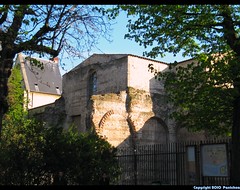 Image by Pantchoa via Flickr
Image by Pantchoa via FlickrBy Harry Preston 
This is one of the treasures of Paris that every visitor should see. Dating from the 1500s and built to designs inspired by the Abbot Jacques d'Amboise, the museum is beautifully preserved and one of the finest examples of 16th-century domestic architecture in France. It has changed little over the centuries, and transports visitors back to a fascinating era.
Gothic turrets herald your approach to the mansion, surrounded by re-created medieval gardens giving off a heady scent of flowers. Inside, a collection of approximately 23,000 items, amassed largely by Alexandre du Sommerard, a 19th-century collector of medieval memorabilia, features tapestries, costumes, textiles and metals from several continents. Many of the textiles and tapestries are European or Byzantine. Some of the most mesmerising pieces include La Dame ala Licome, woven in the 1400s and one of the world's most famous tapestries from that period. Jewels and artifacts made of gold and other metals, including a magnificent glistening altar front, originate from Gallic, Barbarian, Merovingian and Visigothic eras.
Notice the Visigothic votive crown, and an Averbode altarpiece. There is also a seemingly endless collection of books, manuscripts, ceramics, wood carvings and religious items. And do not miss the collection of exquisite stained glass. The Musee National de Cluny is famed for being the site of the Roman Baths in the adjoining Hotel de Cluny. Dating from the 2nd century ad and in remarkably good condition, the baths comprise three chambers: the steam room, known as the Caldarium; the tepid bath or Tepidarium, and the Frigidarium, or cold bath. Roman architecture is still in evidence, such as the labyrinth of vaulted rooms, and the remains of a gymnasium.

This is one of the treasures of Paris that every visitor should see. Dating from the 1500s and built to designs inspired by the Abbot Jacques d'Amboise, the museum is beautifully preserved and one of the finest examples of 16th-century domestic architecture in France. It has changed little over the centuries, and transports visitors back to a fascinating era.
Gothic turrets herald your approach to the mansion, surrounded by re-created medieval gardens giving off a heady scent of flowers. Inside, a collection of approximately 23,000 items, amassed largely by Alexandre du Sommerard, a 19th-century collector of medieval memorabilia, features tapestries, costumes, textiles and metals from several continents. Many of the textiles and tapestries are European or Byzantine. Some of the most mesmerising pieces include La Dame ala Licome, woven in the 1400s and one of the world's most famous tapestries from that period. Jewels and artifacts made of gold and other metals, including a magnificent glistening altar front, originate from Gallic, Barbarian, Merovingian and Visigothic eras.
Notice the Visigothic votive crown, and an Averbode altarpiece. There is also a seemingly endless collection of books, manuscripts, ceramics, wood carvings and religious items. And do not miss the collection of exquisite stained glass. The Musee National de Cluny is famed for being the site of the Roman Baths in the adjoining Hotel de Cluny. Dating from the 2nd century ad and in remarkably good condition, the baths comprise three chambers: the steam room, known as the Caldarium; the tepid bath or Tepidarium, and the Frigidarium, or cold bath. Roman architecture is still in evidence, such as the labyrinth of vaulted rooms, and the remains of a gymnasium.
For more information about Paris, France visit GuidedTourParis.com.
For more information about Phoenix, Arizona visit GuidedTourPhoenix.com.
For more information about Phoenix, Arizona visit GuidedTourPhoenix.com.
Article Source: http://EzineArticles.com/?expert=Harry_Preston
